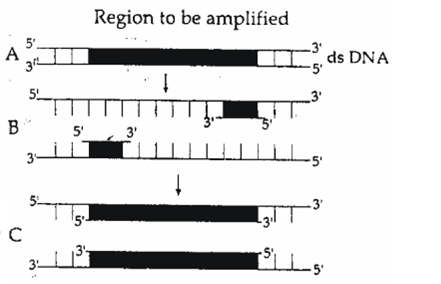 Multiple Choice Questions
Multiple Choice QuestionsCommonly used vectors for human genome sequencing are
T-DNA
BAC and YAC
Expression vectors
Expression vectors
Read the following four statement.
1. In transcription, adenosine pairs with uracil
2. Regulation of lac operon by repressor is referred to as positive regulation.
3. The human genome has approximately 50,000 genes.
4. Haemophilia is sex-linked recessive disease.
How many of the above statements are right?
Two
Three
Four
Four
Select the correct option.
|
Direction of RNA Synthesis |
Direction of reading of the template DNA strand |
|
5’-3’ |
3’-5’ |
|
Direction of RNA Synthesis |
Direction of reading of the template DNA strand |
|
3’-5' |
5’-3' |
|
Direction of RNA Synthesis |
Direction of reading of the template DNA strand |
|
5’-3’ |
5’-3' |
|
Direction of RNA Synthesis |
Direction of reading of the template DNA strand |
|
5’-3’ |
5’-3' |
What is it that forms the basis of DNA fingerprinting?
The relative proportions of purines and pyrimidines in DNA
The relative difference in the DNA occurrence in blood, skin and saliva
The relative amount of DNA in the ridges and grooves of the fingerprints
The relative amount of DNA in the ridges and grooves of the fingerprints
The figure below shows three steps (A, B, C) of Polymerase Chain Reaction (PCR). Select the option giving correct identification together with what it represents?
B – Denaturation at a temperature of about 98°C separatiing the two DNA strands
A – Denaturation at a temperature of about 50°C
C – Extension in the presence of heat stable DNA polymerase
C – Extension in the presence of heat stable DNA polymerase
Select the correct option:
| Column I | Column II | |
| A | Synapsis aligns homologous chromosomes | 1. Anaphase-II |
| B | Synthesis of RNA and protein | 2. Zygotene |
| C | Action of enzyme recombinase | 3. G2-phase |
| D | Centromeres do not separate but chromatids move towards opposite poles | 4. Anaphase-I |
| 5. Pachytene |
Gene regulation governing lactose operon of E.coli that involves the lac I gene product is
Positive and inducible because it can be induced by lactose
Negative and inducible because repressor protein prevents transcription
Negative and repressible because repressor protein prevents transcription.
Negative and repressible because repressor protein prevents transcription.
In sea Urchin DNA, which is double stranded, 17% of the bases were shown to be cytosine. The percentages of the other three bases expected to be present in this DNA are:
G 34%, A 24.5%, T 24.5%
G 17%, A 16.5%, T 32.5%
G 17%, A 33%, T 33%
G 17%, A 33%, T 33%
What are those structures that appear as 'beads-on-string' in the chromosomes when viewed under electron microscope?
Nucleotides
Nucleosomes
Base pairs
Base pairs
B.
Nucleosomes
Nucleosome is sub-microscopic sub-unit of chromatin which is formed by wrapping of DNA over a core of histone proteins. The term was coined by Oudet et. al, (1975). It is oblate structure with a length of 10 nm and a thickness of 5-5.7 nm. Its core is called nu-body. The latter is formed of four pairs of histone molecules - H2A, H2B, H3 and H4. DNA makes 1.75 turns over the octamer to form a nucleosome. Two adjacent nucleosomes are connected by a short segment of unbound DNA called linker DNA. A fifth type of histone called H1 is attached over the linker DNA. Nucleosomes appear as 'beads-on-string' in the chromosomes under electron microscope.
The process of RNA interference has been used in the development of plants resistant to
fungi
viruses
insects
insects
